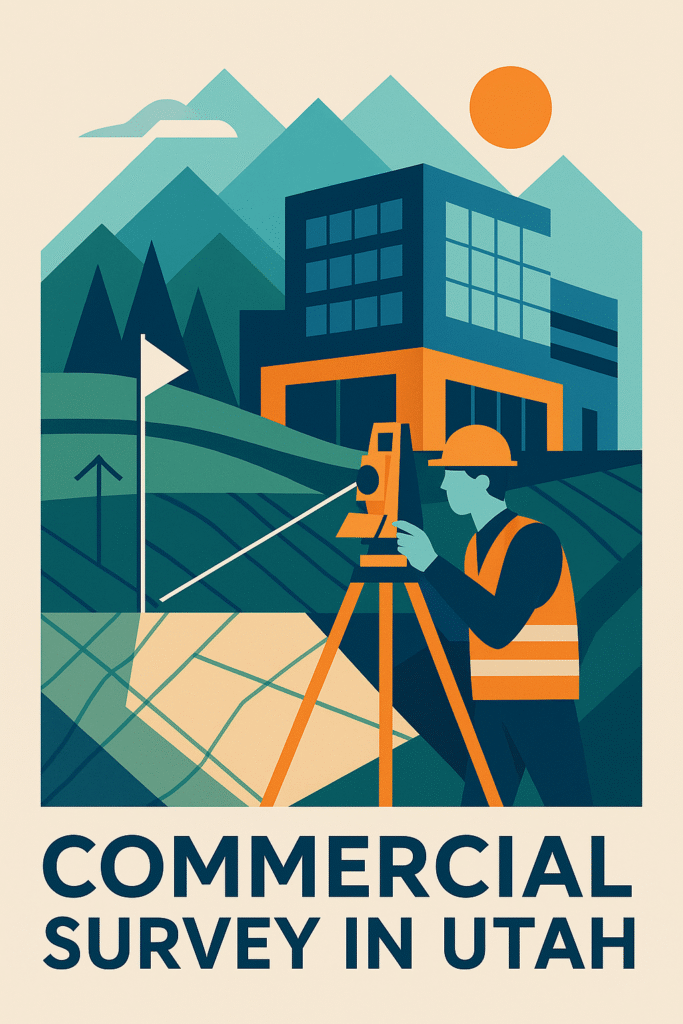
TL;DR:
Accurate commercial land surveys in Northern Utah reduce risk, protect investments, and streamline real estate deals—request a quote today.
Why Commercial Land Surveys Matter in Northern Utah
In Utah’s dynamic real estate market, commercial land surveys are more than technical paperwork—they’re the legal and financial backbone of every transaction. Lenders, developers, real estate agents, and lawyers rely on surveys to ensure:
- Clear contract boundaries
- Timely mortgage approvals
- Smooth title insurance underwriting
At Anderson Engineering, our licensed team delivers fast and accurate surveys to help avoid disputes, delays, and wasted expenses associated with unclear boundaries.
What Is a Commercial Real Estate Land Survey in Utah?
A commercial real estate land survey is defined:
- Legal boundary lines, including easements and right of way
- Topographic details affecting drainage, infrastructure, and sustainability
- Precise metes and bounds descriptions
We utilize lidar and laser scanning, alongside drones, traditional survey equipment, GPS, and historic deed analysis, to produce lender-ready surveys that support real estate appraisal, asset management, and development approvals.
Common Commercial Land Survey Types Explained
| Survey Type | Purpose | When to Use It |
|---|---|---|
| Boundary Survey | Defines property lines via metes and bounds | Commercial sales, lease agreements, disputes |
| Topographic Survey | Maps elevation, terrain, and infrastructure | Site planning, drainage, modern methods of construction |
| ALTA/NSPS Survey | Legal + physical site data for financing | Essential for title insurance, mortgage, and compliance |
| Construction Staking | Accurate site layout marking | Before building—required for precise construction |
| Easement Survey | Clarifies access, leasehold estate rights, and boundaries | Development, utilities, land use planning |
Our ALTA/NSPS surveys comply with American Land Title Association (ALTA) standards, which are critical for title insurance and lender acceptance.
Why Commercial Surveys Differ from Residential
Commercial land surveying requires:
- Greater skill and technical expertise
- Familiarity with real estate investment trusts (REITs), large-scale projects, and debt financing
- Compliance with ALTA/NSPS standards essential for securing mortgages and title insurance policies
The Value of Local Knowledge in Northern Utah
Our team at Anderson Engineering brings region-specific expertise in:
- Public sector regulations
- Environmental sustainability and infrastructure challenges
- Easement enforcement, lease issues, and procurement
Why You Need a Commercial Surveyor for Your Project
A qualified commercial surveyor:
- Helps manage asset management and valuation risk
- Ensures accuracy for real estate appraisals and mortgage underwriting
- Supports construction surveying and project execution
Our Surveying Expertise: Beyond the Basics
At Anderson Engineering, we use:
- Lidar and laser scanning
- Drones and robotic stations
- Specialists in quantity surveying, procurement, and risk management
How Surveys Safeguard Transactions
Surveys:
- Secure title insurance policies
- Mitigate contract disputes
- Reduce exposure to legal costs and audit findings
When Construction Staking is Critical
- Aligns real-world site work with design
- Supports modern methods of construction
- Ensures accurate infrastructure and utility placement
Avoiding staking errors saves cost and prevents future expense.
Our Survey Process in Northern Utah
We follow a rigorous process:
- Historical research and deed analysis
- Field measurements using lidar, laser, and drones
- Licensed, exam-certified professionals validate results
- Reports delivered for title insurance, mortgage, and zoning approvals
Learn more at Anderson Engineering.
ALTA/NSPS Surveys: Essential for Title and Finance
ALTA/NSPS surveys are required for:
- Securing title insurance
- Approving mortgages
- Managing risk in commercial real estate survey transactions
We meet every American Land Title Association standard.
Survey Costs, Timelines, and Value
Typical commercial survey price range:
| Survey Type | Cost Estimate | Turnaround |
|---|---|---|
| Boundary Survey | $3,000–$5,000 | 7–10 business days |
| ALTA Survey | $5,000–$15,000+ | 2–4 weeks |
| Construction Staking | Varies by scope | As required |
Early surveys protect interest rate locks and prevent costly delays.
How Surveys Support Zoning and Compliance
Land surveys help secure:
- Public sector development approvals
- Clarify leasehold estate boundaries
- Plan sustainable infrastructure
Accurate surveys reduce legal exposure and streamline procurement processes.
Reducing Financial and Legal Risk
Surveys:
- Prevent debt overruns and legal challenges
- Reduce reliance on expensive lawyers
- Ensure correct asset management for long-term ownership
Utah Surveying Challenges
Utah’s landscapes present challenges:
- Varied topography
- Discrepant historical metes and bounds records
- Weather delays affecting construction surveying
We overcome these through advanced technology and sustainable planning.
Request Your Commercial Land Survey Quote
Protect your project, reduce risk, and stay on schedule with a precision commercial land survey from Anderson Engineering.


